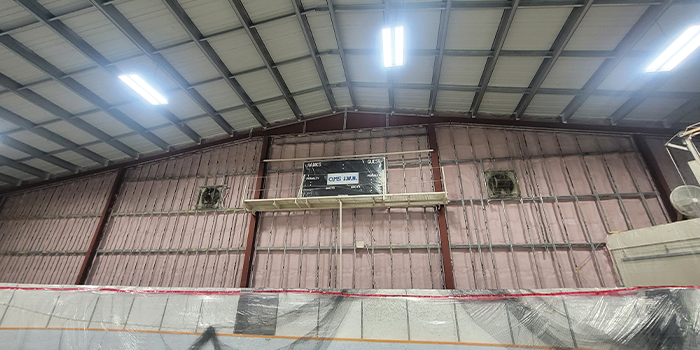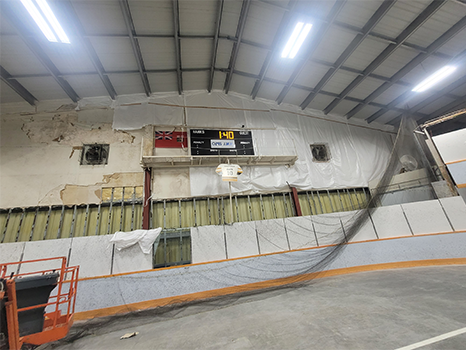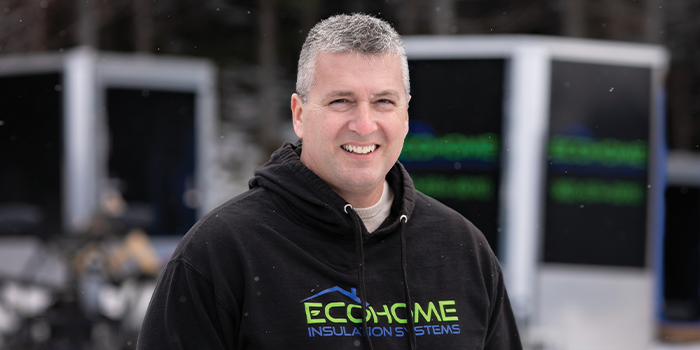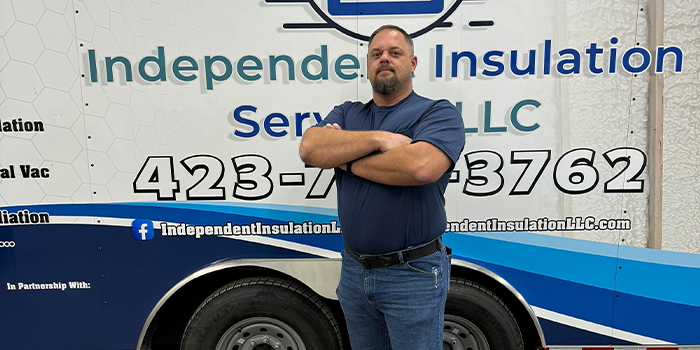
Ice Attitude

SPRAY FOAM MAGAZINE – Located in the province of Manitoba, Canada, St. Adolphe is a small community bursting with character. Despite its size, it has lots of attractions from its beautiful prairie agriculture to its scenic red river, making it a must see for tourists and people in the capital city of Winnipeg where St. Adolphe is only a 20-minute drive south. It’s in this quaint town where the Spray Foam Magazine Team (SFMT) met with one local, born and raised there to find out why he went on a mission to preserve a locally famous venue from a timely demise.
The St. Adolphe Community Club & Arena has both ice and roller-skating rinks, and it has been part of this local community since 1988. It’s a popular place where locals gather, they can ice or figure skate and even join a hockey league. However, there were serious issues with this ice rink, specifically the north wall of the structure, built 30 years ago. It was originally installed with conventional batt insulation, which had rotted away. The strong north winds of Southern Manitoba helped cause the rot, and the serious mold and moisture issues, which then pushed through the two layers of drywall.

In addition to that issue, the ice plant broke down and needed major and costly repairs including a new compressor and a chiller. There had to be a major rebuild, but who was going to complete the insulation job and help prevent such a disaster from happening in the future?
Chris Lenchyshyn is the owner of Cold Country Spray Foam, his family has lived in the Manitoba area for the last three generations. In 2014, Cold Country started to specialize in SPF applications. They entered the SPF business after deciding to purchase equipment to spray their large farm shops. Word spread of their quality insulation job to their neighbors, who also needed insulation work, and soon they developed a large client base and a full-time business. Chris originally ran the company and as business expanded, his brother Jeremy and sister Amy were added to the staff. The company is always striving to become an essential part of the Canadian construction industry’s movement into eco-friendly products and services.
The Lenchyshyn family was originally in food production and owned a farm before they entered the insulation business. Farmers in Canada spend much of their working lives trying to cut costs. This practice made the Lenchyshyns very aware of products and services that focus on saving the clients some of their hard-earned money. They educate their clients on how spray foam insulation is not only saving them money over time, but also by choosing and upgrading to spray foam insulation they are helping conserve energy. Cold Country also has a concrete lifting division named Slab-Jack Kings and they like to explain to their clients that choosing to lift settled concrete versus replacing it is less wasteful and will also save them money. In fact, their company ethos is, ‘Earn A Living by Saving People Money and Preserving the Planet.’

The Canadians are the pioneers of the modern ice-rinks that we are accustomed to today. One may say, it’s part of their cultural heritage. Although, the first ice rinks were thought to have materialized in Scandinavia as early as 1000 BCE, Canada developed the modern ice-skating rinks, with the first made outdoor commercial rink in the country opening in Montréal in 1850, and the first covered rink in the world built in Québec City in 1852.
When Chris and his family heard about their local ice rink having difficulties, they knew they had to get involved. Like many other locals, Chris learned how to skate at this rink. “We have supported our community throughout the years, and we knew we needed to help with this project so the next generations would benefit from a great community-based place. One day my kids may play hockey there, so it was a given to donate materials and labor when the rink needed help,” explained Chris.
Chris explained why the area required SPF, “The north wall of the super structure was built without a proper vapor barrier and with Manitoba having a cold winter climate, down to -50C, the wall took a toll and had extreme mold growth on the wall cavities. SPF was the only answer due to the cavity size and vapor and air barrier permeance needed.”
Water is the main factor to mold development, with infiltrations commonly found in damp, humid places. Mold also leans towards developing on the surface of materials, for example, sheetrock and wood. Exposure to mold can result in itchy eyes, sneezing, coughing and other upper respiratory symptoms. Individuals with pre-existing lung conditions or weakened immune systems are particularly vulnerable. If the mold comes in contact with the skin, it can cause irritation and itchiness. In the case of the St. Adolphe Community Club & Arena Ice and Roller Skating Rink, the mold was extensive and therefore, it was too late to clear any small patches of mold and the entire area had to be replaced.
In the matter of a few years, mold can have a drastic impact on structural framing and can be compromised by the effects of mold growth. Preventing mold will save money in the long run. Being proactive about mold prevention by drying any flooded area, repairing leaky pipes, and controlling temperatures and reducing humidity levels will help. However, having spray foam insulation installed will greatly prevent mold from developing in the first place.
By sealing windows, doors, walls, roofs, and electrical outlets, moisture control is increased. The foam will decrease mold exposure where moisture may meet the material. Once foam is sprayed onto surfaces, or applied inside the wall cavities, it expands filling in spaces and making the area water-resistant, eliminating any mold problem from occurring in addition to being a superior insulator and air sealant.
The Cold Country Spray Foam crew wore full PPE for this project including supplied fresh air masks with Bullard fresh air systems. The SPF applied to the corrugated steel, steel purlins, and resilient channel strapping was Elastochem’s Insulthane Extreme 2lb closed-cell foam. The four person crew used a pull behind 16ft trailer. After the major rebuild of the rink, they applied an R24 four inches to monolithically seal the steel superstructure wall and super insulate it so it would never have issues again. The application took one day which also included the masking and prep. There was nothing out of the ordinary on this job, other than the score and rink puck boards being in the way of the crew spraying, they were able to use a man lift to make it easier to get to the area behind the boards.
This was a project that the Lenchyshyn family were honored to be part of, and according to Chris, “The client was thrilled with the result and families in the local area are ecstatic that they have a refurbished ice rink. We supplied foam to my hometown community at cost so future generations can continue to use it without problems ever again.”
Cold Country Spray Foam applied both spray foam and a belief in longevity and substantiality to a local project close to their heart. Transferring valuable skills, they learned in the farming industry and combining that with an honest and hardworking approach, this company has not only saved their client money in the long run, but they have also helped save a treasured local ice rink.
For use by SprayFoamMagazine.com & Spray Foam Magazine













